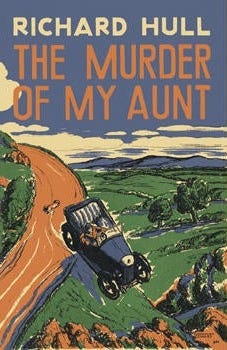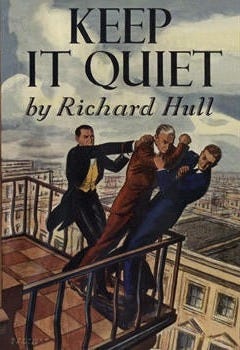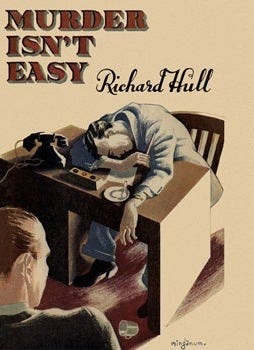One of the authors I’ve really enjoyed exploring over the last year is Richard Hull. Sadly, only two of his novels are currently in print in the UK, so you’ll have to look out on the second-hand market for the others.1 But I hope more will be reprinted again soon, because he was a wonderfully creative writer who deserves to be more widely read.
He wasn’t from Hull, though
Despite his pen-name, Richard Sampson was born in London, in 1896 (the same year as Josephine Tey and Oswald Mosley). His career path involved an unusual combination of chartered accounting, naval auditing, and crime writing. By his own admission, he was better at the latter than the former, commenting: “I never liked accounting and I never was a good accountant.”2
He was inspired to try his hand at crime fiction after reading Francis Iles’ novel Malice Aforethought (1931), a brilliant inverted detective story (that is, one where the identity of the murderer is known from the beginning). Hull’s first contribution to the genre appeared in 1934, The Murder of My Aunt. This introduced what would become his trademark creative approach to inverted detective novels, as summed up by the dust jacket: “The author plays the game with fair rules, but new rules of his own making.” He wrote a total of 15 novels, ending with The Martineau Murders in 1953.
Throughout his oeuvre, Richard Hull specialised in deploying unusual plot structures, unreliable narrators and ironic twists. He wrote with a wry humour, and enjoyed chronicling the undoing of over-confident, naive or hapless criminals. I like the way Martin Edwards summed up his work: “He explored the misadventures of the malevolent with formidable inventiveness.”3
I’ve now read a third of his output — three of the novels were excellent, the other two were sadly lacking. In both of the disappointing cases, Hull had an ingenious idea, but was not able to exploit it to its full potential. Left-Handed Death (1946) starts with a conversation discussing a murder, followed by a confession, but the actual identity of the murderer is kept ambiguous. The execution of the plot felt rushed, however. Last First (1947) begins with the last chapter, cleverly giving the solution without giving the solution. Sadly, the plot gets bogged down in discussions about fishing.
But that’s enough about his less successful adventures. Here are my reflections on my three favourite Hull novels (so far).
The Murder of My Aunt (1934)
You can definitely see the Francis Iles influence in this debut novel, though Hull proves himself an accomplished novelist in his own right. The premise is simple — Edward Powell wants to murder his aunt, who lives in the Welsh town of Llwll, and tries to concoct a plan that will make this possible. In the hands of Hull, this simple premise becomes an irresistible delight, filled with darkly humorous twists.
Alongside the very enjoyable plot, two things make this novel stand out in my mind. One is Powell himself. Hull has created one of the most unlikeable narrators in the history of crime fiction. As a Welsh resident, I was obviously immediately aggravated by the opening page criticising the unpronounceability of Welsh place names, concluding with his summary assessment of the country: “A more horrible place I have never seen.” As the novel continues, there is no ambiguity about what our sentiments towards him should be. Hull creates a lot of humour out of his sheer obnoxiousness.
The other really wonderful part of this book is the ending. Without spoiling it for you, the last chapter was an unexpected treat, with one of the best final paragraphs in any novel I’ve read. If you liked the ending of Malice Aforethought (which inspired Hull) I’m sure you’ll love this too.
I agree with the Saturday Review of Literature, which described it on publication as “required reading”. Go and get a copy!
Verdict: ⭐⭐⭐⭐⭐ (5/5)
The Murder of My Aunt has also been reviewed by Crossexamining Crime, Mysteries Ahoy!, the Puzzle Doctor, and Stuck in a Book.
Keep It Quiet (1935)
Keep It Quiet was actually my first experience of Richard Hull’s writing, and convinced me that I needed to read more. It’s another darkly entertaining slice of comic crime set in a fictional gentleman’s club, where Ford the secretary attempts to cover up the death of a club member. It turns out that covering up a death is not as easy as Ford first assumes.
Hull’s real-life networks seem to have been an inspiration for this novel. He was a member of the United University Club in Suffolk Street, writing: “I have many friends there and a satisfactory supply of enemies.” You wonder which of Hull’s enemies might have recognised themselves in the novel’s character list.
As with The Murder of My Aunt, Hull provides a consistent level of wry humour, as the chaotic chain of events progresses through blackmail, book thefts, crossed wires and power plays. Each new development draws you into the plot as you watch to find out how badly it will all end.
When I first read Keep It Quiet, I was a bit annoyed with Hull for not playing entirely fair in one of the early chapters, which affected my experience of one of the twists in the middle of the book. If I re-read it, I think I would instead appreciate this as another mark of Hull’s ingenuity and inventiveness, playing by “new rules of his own making.”
Keep It Quiet is currently out-of-print, but fairly easy to pick up secondhand at a reasonable price.
Verdict: ⭐⭐⭐⭐ (4/5)
Keep It Quiet has also been reviewed by Cross Examining Crime, the Puzzle Doctor, the Grandest Game in the World, and Jason Half.
Murder Isn’t Easy (1936)
Three years before Agatha Christie declared that Murder Is Easy, Richard Hull proclaimed the opposite: “Murder, you know, sir, is not easy. Nor is the solution of it always as simple as you appear to think.” Murder Isn’t Easy offers another clever twist on the inverted detective format, this time set in the world of advertising agents.
Hull crafted some good opening lines, and this gets off to an immediately promising start: “There is a limit to the extent to which the folly of any man can be allowed to ruin a business, and beyond that limit Paul Spencer has certainly gone.” The following pages chronicle Nicholas Latimer’s reflections on how to deal with his colleague. As the title suggests, this leads to thoughts of murder.
At this point, it’s difficult to say much more without spoiling the plot. But one of the first things you’ll notice when you open the book is the table of contents. Part 1 is entitled “Design and Plot”, and Part 2 is entitled “Counterplot”. That may give you some idea of where the novel leads — but only some idea. I completely failed to predict how things would actually unfold. The opening paragraph of Part 3 was so unexpected it made me genuinely laugh out loud. Part 4 was even more incredible, and also includes a very funny appearance of a Welshman.
There are still a few months left of 2024, but I’m fairly sure this will end up being my favourite novel of the year. It’s absolutely stunning — and will hopefully get another reprint soon.
Verdict: ⭐⭐⭐⭐⭐ (5/5)
Murder Isn’t Easy has also been reviewed (though watch out for spoilers) by Crossexamining Crime, The Puzzle Doctor, The Invisible Event and Jason Half.
I hope this inspires you to read some Richard Hull if you haven’t already. I have three other Hulls on my shelf, so keep an eye out for a sequel in a few months too.
The Murder of My Aunt and Excellent Intentions have both been republished in the British Library Crime Classics series. This Richard Hull is not the same Richard Hull who wrote , Jews and Judaism in African History (Markus Wiener Publishers, 2009) or the Richard Hull who edited the ASE Secondary Science Teachers' Handbook (Oxford University Press, 1995).
Quoted in Martin Edwards’ introduction to the British Library edition of Excellent Intentions.
The Story of Classic Crime in 100 Books (British Library, 2017), p. 208.








I have purchased 'The Murder of My Aunt' on your commendation. I expect great things.